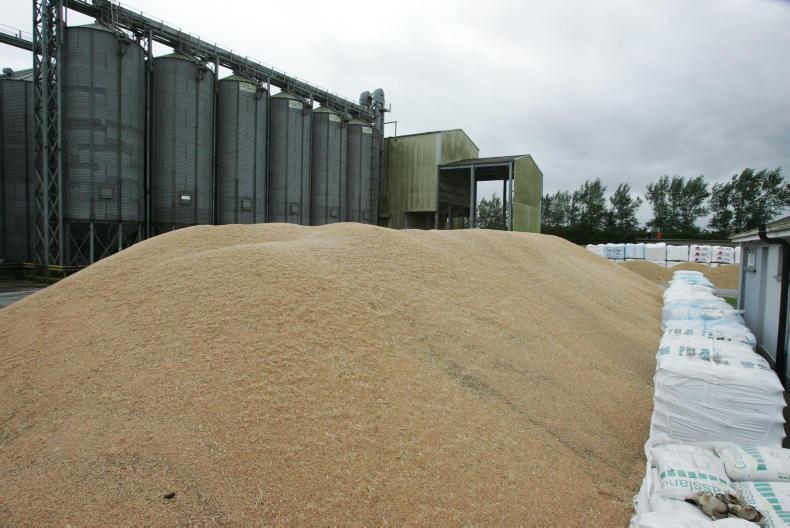Irish tillage farmers are facing into another year of poor grain prices as another bumper global harvest this season has left the world oversupplied in grain. 2016 will be the fourth consecutive year we have seen a bountiful global harvest and prices have been below the cost of production for growers in many parts of the world for a number of years.
In Ireland, the situation is no different for tillage farmers, with green prices for barley looking to be in the region of €125/t, while wheat will trade for €8 to €10/t above this. Right now, Irish growers are wrapping the annual harvest that will see some 2.2m tonnes of cereals fill grain stores for another year. Cereal production in Ireland decreased 15% to 2.2m tonnes in 2016, following a record harvest in 2015. Of this, wheat production was just under 600,000t, oat production was 163,000t, while Irish growers produced more than 1.34m tonnes of barley.
Of Irish barley production, 188,000t is used to produce malt for the brewing and distilling industry, while a further 30,000t is used for roasting by Diageo. 50,000t of the malting barley is used by the Irish distilling industry for use in spirits.
The remaining 1.1m tonnes of Irish barley is used by the animal feed sector.
Of Ireland’s annual oat crop, about 20,000t is used by Flahavan’s to manufacture its porridge and other products, while Glanbia also uses around 15,000t to 20,000t for its porridge range. The balance is mostly used as equine feed or sent for export. Most of Ireland’s wheat crop is used in animal feed, with less than 5% used for milling.
Quality issues
However, in recent weeks fresh questions have been raised by the IFA and farmers around the quantity and quality of grain imports coming into Ireland.
While there is a need for some grain imports as Ireland is only 80% self-sufficient in grain, many tillage farmers have been asking why such large volumes are being imported, especially at the height of the harvest period.
According to figures from the Central Statistics Office (CSO), Ireland imported 1m tonnes of cereals in 2015. Maize is the largest cereal crop imported on to these shores with some 900,000t shipped last year.
Some 95,000t of wheat was imported. This is needed to fill the shortfall in Irish wheat production needed by the animal feed industry here, with the majority of this wheat imported from the UK.
On top of this, 34,000t of barley was imported last year, along with 12,000t of barley seed and 16,000t of malt. The majority of these imports are shipped from Ukraine, France and some Eastern European states.
However, it is important to acknowledge that Ireland is more than self-sufficient in barley and on balance any barley imported here is ultimately destined for Northern Ireland. For instance, 48,000t of barley was exported from Ireland to the north in 2015.
The majority of grain imports to Ireland are destined for the animal feed market, which is the largest input to agriculture. The total feed market is around 4-4.5m tonnes, with an estimated value of over €1bn.
Large volumes of other grain and feed additives are imported by the milling industry every year for use in more complex and higher protein animal feeds.
In 2015, just under 450,000t of soya were imported, mainly coming from Argentina. A further 700,000t of other high-protein feed products are also imported.
Comment
A tillage stakeholder group, made up of farmers, grain merchants and feed compounders, explored the future potential of the Irish tillage sector last year and made a submission to the FoodWise 2025 report. It found the sector has the potential to increase wheat and barley output by 750,000t to 2.8m tonnes.
This increase in production would more than displace the grain currently imported for use in animal feed rations. With global grain markets becoming increasingly more volatile, the animal feed sector is exposed to the vagaries of global economic dynamics.
Ireland has developed a premium image for our food industry under the Origin Green label, but excessive reliance on imported protein and grains is a potential threat to our high-end brand and marketing campaigns.
Developing greater protein crop production in Ireland would allow the industry to substitute away from imported products currently used by the compound feed manufacturing sector. This would benefit the animal sectors, while aiding the marketing of home-produced traceable non-GM product.
It would also provide opportunities for closed-loop, high-value, sustainable, supply chain products through the animal sectors, while also enhancing the viability of the Irish tillage sector. To get there involves a number of factors, including buy-in from the animal feed trade, commitment from tillage farmers and specific research programmes.
A move to a system such as this would allow for greater transparency around labelling and origin in animal feed rations.
